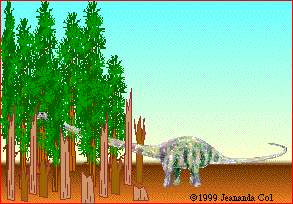
 |
| You might also like: | Leonardo da Vinci: Proportions of the Human Figure Coloring Page | Dinosaur Evolution - ZoomDinosaurs.com | Today's featured page: Plant Theme Pages Theme Pages: K-3 Themes |
| Our subscribers' grade-level estimate for this page: 4th |
| Triassic Plants | Jurassic Plants | Cretaceous Plants |
 Without plants, there would have been no dinosaurs (or any other land animals).
Without plants, there would have been no dinosaurs (or any other land animals).
Meat-eating animals (carnivores like Tyrannosaurus rex) get their energy by eating other animals, mostly plant-eating animals (herbivores like Triceratops). The herbivores get their energy by eating plants (like cycads). The plants (producers or autotrophs) get their energy from sunlight, converting the light into chemical energy using photosynthesis. |
Leptocycas was a cycad, a primitive seed plant from the late Triassic period. It was a palm-like tree with a long, woody trunk and tough leaves. It lived in warm climates. This tree was about 4.8 ft (1.5 m) tall. |
Williamsonia sewardiana was a cycadeoid (a bennettitalean). It had a woody stem and simple leaves. |
Horsetails were an important source of nutrition for plant-eating dinosaurs. These primitive vascular plants were fast-growing and resilient (they could propagate using underground runners which a grazing dinosaur wouldn't eat). This meant that a hungry dinosaur could eat the plant without killing it, since the plant would regrow from the rhizome (the underground stem). |
Glossopteris, a tree-like seed fern (Pteriosperm) from the Permian through the Triassic Period. It had tongue-shaped leaves and was about 12 ft (3.7 m) tall. Glossopteris was a dominant plant in Gondwana (the southern supercontinent) early in the Triassic period. |
| The Mesozoic Era (248 - 65 million years ago) Ages of the Mesozoic Era | ||||||||
| Triassic Period 248 - 206 mya First dinosaurs and mammals |
Jurassic Period 206-144 mya Many dinosaurs and the first birds |
Cretaceous Period 144-65 mya First flowering plants, the height of the dinosaurs. Ends in huge extinction. |
||||||
| Early - Middle 248-227 mya |
Late 227-206 mya |
Early (Lias) 206-180 mya |
Middle (Dogger) 180-154 mya |
Late (Malm) 154-144 mya |
Early (Neocomian) 144-127 mya |
Middle (Gallic) 127-89 mya |
Late (Senonian) 89-65 mya |
|
Enchanted Learning®
Over 35,000 Web Pages
Sample Pages for Prospective Subscribers, or click below
|
Overview of Site What's New Enchanted Learning Home Monthly Activity Calendar Books to Print Site Index K-3 Crafts K-3 Themes Little Explorers Picture dictionary PreK/K Activities Rebus Rhymes Stories Writing Cloze Activities Essay Topics Newspaper Writing Activities Parts of Speech Fiction The Test of Time
|
Biology Animal Printouts Biology Label Printouts Biomes Birds Butterflies Dinosaurs Food Chain Human Anatomy Mammals Plants Rainforests Sharks Whales Physical Sciences: K-12 Astronomy The Earth Geology Hurricanes Landforms Oceans Tsunami Volcano |
Languages Dutch French German Italian Japanese (Romaji) Portuguese Spanish Swedish Geography/History Explorers Flags Geography Inventors US History Other Topics Art and Artists Calendars College Finder Crafts Graphic Organizers Label Me! Printouts Math Music Word Wheels |
Click to read our Privacy Policy
| Search the Enchanted Learning website for: |